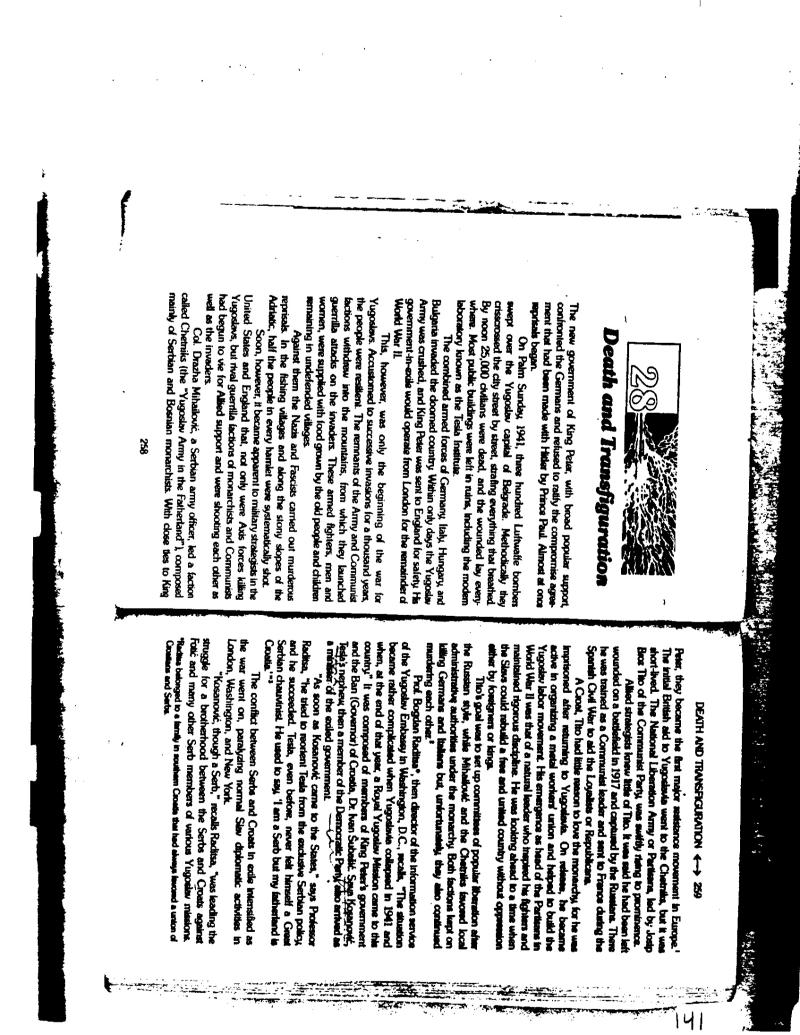
Nikola Tesla Documents
Nikola Tesla FBI Files - Page 141
CA 28 Death and Transfiguration The new government of King Peter, with broad popular support, confronted the Germans and refused to ratify the compromise agreement that had been made with Hitler by Prince Paul. Almost at once reprisals began. On Palm Sunday, 1941, three hundred Luftwaffe bombers swept over the Yugoslav capital of Belgrade. Methodically they crisscrossed the city street by street, straling everything that breathed. By noon 25,000 civilians were dead, and the wounded lay everywhere. Most public buildings were left in ruins, including the modem laboratory known as the Tesla Institute. The combined armed forces of Germany, Italy, Hungary, and Bulgaria invaded the doomed country Within only days the Yugoslav Army was crushed, and King Peter was sent to England for safety His government-in-exile would operate from London for the remainder of World War II This, however, was only the beginning of the war for Yugoslavs. Accustomed to successive invasions for a thousand years, the people were resilient. The remnants of the Army and Communist factions withdrew into the mountains, from which they launched guerrilla attacks on the invaders. These armed fighters, men and women, were supplied with food grown by the old people and children remaining in undefended villages. Against them the Nazis and Fascists carried out murderous reprisals. In the fishing villages and along the stony slopes of the Adriatic, half the people in every hamlet were systematically shot. Soon, however, it became apparent to military strategists in the United States and England that, not only were Axis forces killing Yugoslavs, but rival guerrilla factions of monarchists and Communists had begun to vie for Allied support and were shooting each other as well as the invaders. Col. Drazha Mihailović, a Serbian army officer, led a faction called Chetniks (the "Yugoslav Army in the Fatherland"), composed mainly of Serbian and Bosnian monarchists. With close ties to King 258 DEATH AND TRANSFIGURATION →→→→→> 259 Peter, they became the first major resistance movement in Europe.' The initial British aid to Yugoslavia went to the Chetniks, but it was short-lived. The National Liberation Army or Partisans, led by Josip Broz Tito of the Communist Party, was swiftly rising to prominence. Allied strategists knew little of Tito. It was said he had been left wounded on a battlefield in 1917 and captured by the Russians. There he was trained as a Communist leader and sent to France during the Spanish Civil War to aid the Loyalists or Republicans. A Croat, Tito had little reason to love the monarchy, for he was Imprisoned after returning to Yugoslavia. On relenes, he became active in organizing a metal workers' union and helped to build the Yugoslav labor movement. His emergence as head of the Partisans in World War II was that of a natural leader who inspired his fighters and maintained rigorous discipline. He was looking ahead to a time when the Slays could rebuild a free and unlied country without oppression either by foreigners or kings. Tito's goal was to set up committees of popular liberation after the Russian style, while Mihailović and the Chetniks favored local administrative authorities under the monarchy Both factions kept on Idilling Germans and Italians but, unfortunately, they also continued murdering each other." Prof. Bogdan Raditsa", then director of the information service of the Yugoslav Embassy in Washington, D.C., recalls, “The situation became rather complicated when Yugoslavia collapsed in 1941 and when, at the end of that year, a Royal Yugoslav Mission came to this country" it was composed of members of King Peter's government and the Ban (Governor) of Croatia, Dr. Ivan Šubašić. Sava Kosanović, Tesla's nephew, then a member of the Democratic Party also arrived as a minister of the exiled government. "As soon as Kosanović came to the States," says Professor Raditsa, "he tried to reorient Tesla from the exclusive Serbian policy, and he succeeded. Tesla, even before, never felt himself a Great Serbian chauvinist. He used to say, 'I am a Serb but my fatherland is Croatia ¹3 The conflict between Serbs and Croats in exile Intensified as the war went on, paralyzing normal Slav diplomatic activities in London, Washington, and New York. "Kosanović, though a Serb," recalls Raditsa, "was leading the struggle for a brotherhood between the Serbs and Croats against Fotic and many other Serb members of various Yugoslav missions. *Radisa belonged to a family in southern Croatie that had always favored a union of Capellans and Serbs. 141
